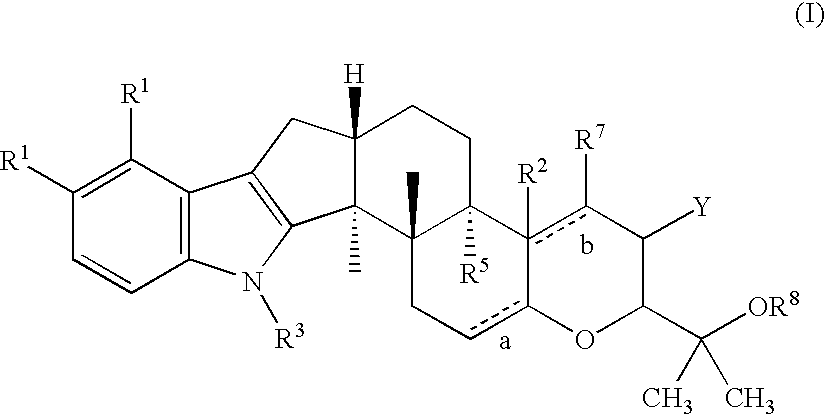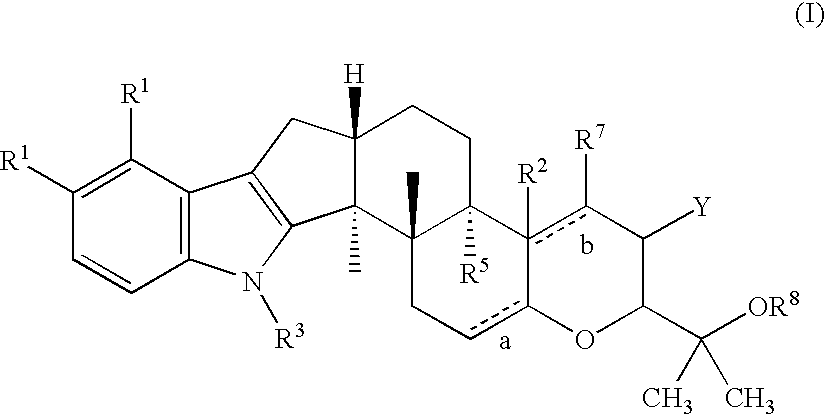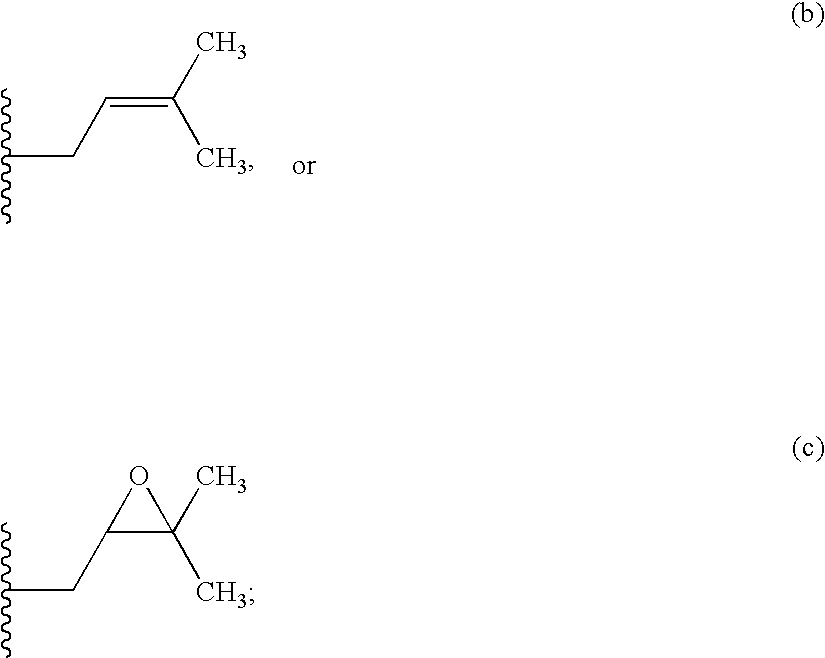Method for treating ocular hypertension
a technology for ocular hypertension and ocular hypertension, which is applied in the field of ocular hypertension treatment methods, can solve the problems of unsatisfactory drugs formerly used to treat glaucoma, unsatisfactory drugs as first-line drugs, and loss of visual function,
- Summary
- Abstract
- Description
- Claims
- Application Information
AI Technical Summary
Benefits of technology
Problems solved by technology
Method used
Image
Examples
example 1
Production of Compounds A, B, C, D and G
Step A: Fermentation Conditions for Production of Compounds A-D and G
[0159]Fermentation conditions for the production of Compounds A, B, C, D and G by the microorganism Nalanthamala sp. were as follows: vegetative mycelia of a culture of the above microorganism were prepared by inoculating 54 mL of seed medium (Table 1) in a 250 mL unbaffled Erlenmeyer flask with frozen mycelia of MF5785 (ATCC 74192). Seed flasks were incubated at 25° C. and 50% relative humidity on a rotary shaker with a 5-cm throw at 220 rpm in a room with constant fluorescent light, about 400 to 750 nm. Two-mL portions of the resulting 3-day culture were used to inoculate 50 mL portions of Liquid Production Medium (Table 2) in 250 mL unbaffled Erlenmeyer flasks; these cultures were incubated at 25° C., 220 rpm with 50% relative humidity in a room with constant fluorescent light. The products appeared in the fermentation as early as 7 days with maximal accumulation observed ...
example 2
Preparation of Methyl Hydroxypaspalinate, Compound E
[0181]To a methanolic solution of the hydroxypaspalinic acid (Compound D, 7.8 mg, 0.016 mM) was added (trimethylsilyl)diazomethane ((CH3)3SiCHN2, 2 M solution in hexanes) in excess. The mixture was stirred at room temperature until the faint yellow color dissipated. The solvent was then removed under nitrogen to give the methyl ester (TLC 5 % CH3OH—CH2Cl2, Rf 0.19 (acid), 0.39 (ester)). It was purified by HPLC on PARTISIL 10 ODS-3 (22×50) using 60% CH3CN-H2O (flow rate 10 mL per min) to afford methyl hydroxypaspalinate (Compound E; M.W. 481). It was eluted at 149.6 min. and has the following formula:
[0182]13C NMR spectrum was recorded in CD3OD at 75 MHz on a Varian XL300 NMR spectrometer at ambient temperature. Chemical shifts are given in ppm relative to tetramethylsilane (TMS) at zero ppm using the solvent peak at 49.0 (CD3OD) ppm as internal standard. 14.8, 16.6, 24.6, 25.4, 25.9, 26.0, 26.2, 28.3, 32.5, 33.7, 40.6, 41.6, 50.3,...
example 3
Synthesis of Paxizoline, Compound F
[0184]Crystalline NH2OH.HCl (32 mg, 0.45 mM) was added to a solution of paxilline (20 mg, 0.045 mM) in C2H5OH (2 mL). The mixture was flushed with nitrogen and stirred until the reaction, monitored by TLC (SiO2, 10% CH3OH—CH2Cl2; Rf 0.67 (ketone) and 0.56 (oxime)), was complete. The solvent was removed, then the residue was transferred to a separatory funnel using ether (5 mL). The organic layer was washed consecutively with water (3×1 mL), saturated aqueous NaCl (1×1 mL), then dried with anhydrous MgSO4, filtered through a sintered glass. The solvent was removed in vacuo. The crude mixture was purified by TLC (SiO2 60 F-254, 5% CH3OH—CH2Cl2) to give paxilline oxime (18.6 mg; C27H34O4N2, M.W. 450.2518 (calcd), 450.2517 (found)).
[0185]To a mixture of paxilline oxime (10 mg, 0.022 mM) and diphenyl disulfide (4.85 mg, 0.022 mM) in dry tetrahydrofuran (2 mL) was added tributylphosphine (9 mg, 0.044 mM). The mixture was stirred at room temperature over...
PUM
| Property | Measurement | Unit |
|---|---|---|
| Volume | aaaaa | aaaaa |
| Volume | aaaaa | aaaaa |
| Volume | aaaaa | aaaaa |
Abstract
Description
Claims
Application Information
 Login to View More
Login to View More - R&D
- Intellectual Property
- Life Sciences
- Materials
- Tech Scout
- Unparalleled Data Quality
- Higher Quality Content
- 60% Fewer Hallucinations
Browse by: Latest US Patents, China's latest patents, Technical Efficacy Thesaurus, Application Domain, Technology Topic, Popular Technical Reports.
© 2025 PatSnap. All rights reserved.Legal|Privacy policy|Modern Slavery Act Transparency Statement|Sitemap|About US| Contact US: help@patsnap.com



